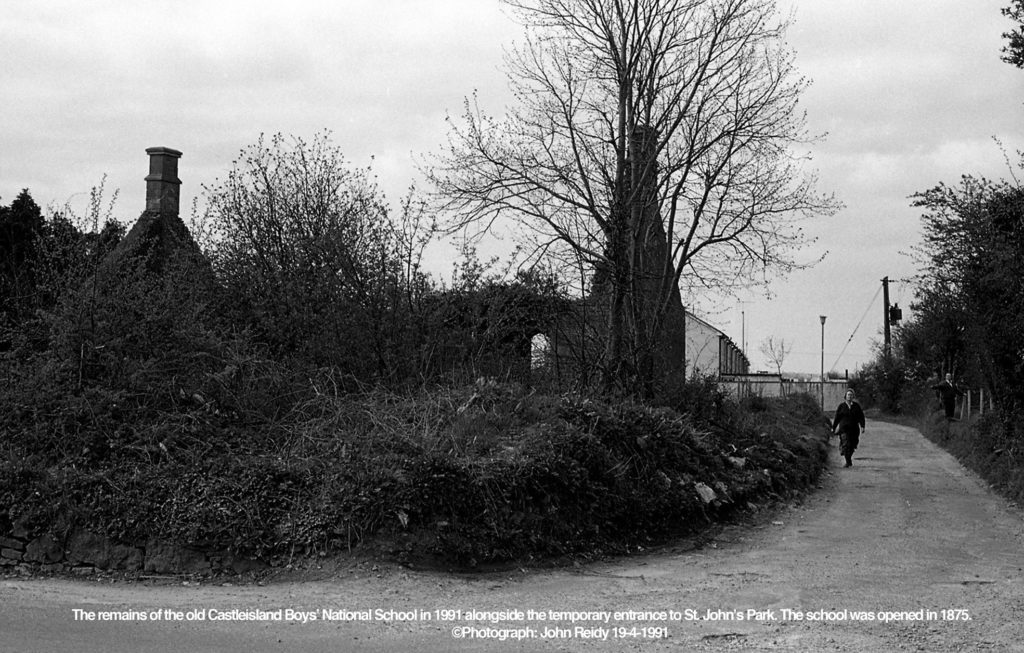The subject of education naturally drew the attention of former principal, Michael O’Donohoe, who studied the role of the Kildare Place Society in the teaching of the young:
On 2 December 1811 The Kildare Place Society was founded in Dublin to promote the education of the poor of Ireland. From 1815 onwards they received annual parliamentary grants but these ceased in 1831 with the introduction of the National School system. From then on the KPS operated on a much reduced scale. In 1846 they undertook the training of CES teachers (Church Education Society for Ireland, set up in Dublin in 1839, in opposition to the Board of National Education, aiding schools without government subsidy) and in 1854 all KPS schools were taken over by the CES.
.
The KPS system operated on the basic principle that teachers should be appointed, and scholars admitted to schools, without distinction of religion. Catechisms and books of religious controversy were excluded (except out of school hours). On 6 January 1812, it was recommended that scriptures be read in all schools, without note or comment. From 10 May 1813 the reading of scripture became mandatory. Books, slates, pencils and other school requisites were supplied free and library books were also provided. In July 1818, it was decided to supplement the incomes of efficient teachers by granting gratuities not exceeding £10. Inspections discontinued from 5 January 1841.1
Kildare Place Society in Castleisland
Michael’s study focussed on the society’s school in Castleisland. Material includes local Church of Ireland clergy involved in the operation of the school including Rev Browning Drew and Rev F R Maunsell, who in 1842 objected to the establishment of a National school in Castleisland because he was ‘opposed to principles of National Board and fears KPS school, under his supervision, would be deserted’.2

Insight into nineteenth century education is gained in a report from the Castleisland Petty Sessions of 1874 when a teacher at Castleisland National School, described as unfit to have charge of a school, was fined £1 and £1 costs for cruelly beating and ill-treating a twelve year old student:
He made the poor creature kneel upon his bare knees on the ground, with his arms extended, and a slate in each hand, and the moment he let his hands clasp he was struck with a rod across the arms. The Head-constable said he saw the child next day and his arms and body were covered with welts. He had seen soldiers after being flogged, and they were not in a worse state.3
See links below to access a selection of material in the collection.
IE MOD-45-45.1-45.1.2
‘Castleisland BNS 1842’ contains notes on teaching staff at the KPS school in Castleisland
IE MOD-45-45.1-45.1.3
‘KPS’ contains references to the school in Castleisland from published articles with associated page number, for example, ‘p195 1833 Temporary closure of Castleisland school a great loss to the poor’. Articles from a series by Pádraig de Brún published in the Journal of the Kerry Archaeological & Historical Society during the years 1979 to 1984 (Part I No 12 (1979), pp63-118; Part II No 13 (1980) pp82-142; Part IIA No 14 (1981) pp 37-93; Part III No 15/16 (1982-3) pp 112-156; Part IV No 17 (1984) pp153-205)
IE MOD-45-45.1-45.1.5
Notes on the history of the Kildare Place Society School in Castleisland from 1825 to 1868, at which period ‘Protestants attending Convent NS’. Notes focus on the school and teaching staff, including Rev Browning Drew and Rev F R Maunsell, and the transition of the KPS school to national school
_____________________
1 IE MOD/45. Michael O'Donohoe's notes were compiled from a series of articles on this subject written by Pádraig de Brún and published during the period 1979-1984. 2 Further reference to Church of Ireland clergy in Castleisland in The Church of Ireland in Co Kerry a record of church and clergy in the nineteenth century (2009). 3 Tralee Chronicle and Killarney Echo, 15 September 1874.


